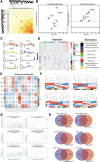Identification of Significant Modules and Targets of Xian-Lian-Jie-Du Decoction Based on the Analysis of Transcriptomics, Proteomics and Single-Cell Transcriptomics in Colorectal Tumor
- PMID: 35256851
- PMCID: PMC8898059
- DOI: 10.2147/JIR.S344861
Identification of Significant Modules and Targets of Xian-Lian-Jie-Du Decoction Based on the Analysis of Transcriptomics, Proteomics and Single-Cell Transcriptomics in Colorectal Tumor
Abstract
Purpose: Colorectal cancer (CRC) remains the third most common tumor worldwide. Ulcerative colitis (UC) could cause chronic inflammation and ulcers in the colon and rectum. UC is a risk factor for a high incidence of CRC, and the incidence of UC-associated CRC (UC-CRC) is still increasing. Chinese medicine prescription, Xian-Lian-Jie-Du decoction (XLJDD), has been proven its efficacy in some UC-CRC patients. However, the mechanism of XLJDD in treating UC-CRC remains unknown. This study aimed to investigate the mechanism of XLJDD in treating UC-CRC.
Methods: We constructed an AOM/DSS mouse model that could simulate the various stages of UC-CRC in humans. XLJDD and its 5 main components are used to treat the AOM/DSS model, respectively. With the power of high-throughput sequencing technology, we described the mechanism of XLJDD from transcriptomics, proteomics, and single-cell transcriptomics.
Results: Our results showed that XLJDD could effectively suppress the occurrence and development of colorectal tumors. Using the weighted correlation network analysis (WGCNA), several mRNA and protein modules that respond to XLJDD have been identified. Moreover, two essential genes, Mfsd2a and Ccdc85c, were caught our attention. They were prognostic markers in CRC patients, and their expression could be significantly modulated by XLJDD, showing their potential as effective targets of XLJDD. In addition, we also discovered that XLJDD could affect the cell composition of the colorectal tumor environment, especially in the infiltration of B cells.
Conclusion: We demonstrated that XLJDD could prevent the initiation and development of colorectal tumors by modulating the expression of Mfsd2a and Ccdc85c and reducing the infiltration of B cells in the tumor microenvironment of colorectal tumor.
Keywords: B cell infiltration; Ccdc85c; Mfsd2a; colorectal tumor; inflammation pathway.
© 2022 Yu et al.
Conflict of interest statement
The authors declare that there are no competing financial interests and conflicts of interest in this work.
Figures







Similar articles
-
Xianlian Jiedu Decoction alleviates colorectal cancer by regulating metabolic profiles, intestinal microbiota and metabolites.Phytomedicine. 2024 Jun;128:155385. doi: 10.1016/j.phymed.2024.155385. Epub 2024 Jan 27. Phytomedicine. 2024. PMID: 38569292
-
Mechanism of Huang-lian-Jie-du decoction and its effective fraction in alleviating acute ulcerative colitis in mice: Regulating arachidonic acid metabolism and glycerophospholipid metabolism.J Ethnopharmacol. 2020 Sep 15;259:112872. doi: 10.1016/j.jep.2020.112872. Epub 2020 May 14. J Ethnopharmacol. 2020. PMID: 32417423
-
Huang-Lian-Jie-Du Decoction Ameliorates Acute Ulcerative Colitis in Mice via Regulating NF-κB and Nrf2 Signaling Pathways and Enhancing Intestinal Barrier Function.Front Pharmacol. 2019 Nov 21;10:1354. doi: 10.3389/fphar.2019.01354. eCollection 2019. Front Pharmacol. 2019. PMID: 31849642 Free PMC article.
-
Research progress on the carcinogenesis mechanism of inflammation in ulcerative colitis: a narrative review.Ann Palliat Med. 2021 Nov;10(11):11994-12002. doi: 10.21037/apm-21-3138. Ann Palliat Med. 2021. PMID: 34872322 Review.
-
Ulcerative colitis-associated colorectal cancer.World J Gastroenterol. 2014 Nov 28;20(44):16389-97. doi: 10.3748/wjg.v20.i44.16389. World J Gastroenterol. 2014. PMID: 25469007 Free PMC article. Review.
Cited by
-
Murine models of colorectal cancer: the azoxymethane (AOM)/dextran sulfate sodium (DSS) model of colitis-associated cancer.PeerJ. 2023 Oct 31;11:e16159. doi: 10.7717/peerj.16159. eCollection 2023. PeerJ. 2023. PMID: 37927787 Free PMC article. Review.
-
A Combination of Microarray-Based Profiling and Biocomputational Analysis Identified miR331-3p and hsa-let-7d-5p as Potential Biomarkers of Ulcerative Colitis Progression to Colorectal Cancer.Int J Mol Sci. 2024 May 23;25(11):5699. doi: 10.3390/ijms25115699. Int J Mol Sci. 2024. PMID: 38891888 Free PMC article.
-
Synthesis, characterization, and efficacy evaluation of a PH-responsive Fe-MOF@GO composite drug delivery system for the treating colorectal cancer.Heliyon. 2024 Mar 15;10(6):e28066. doi: 10.1016/j.heliyon.2024.e28066. eCollection 2024 Mar 30. Heliyon. 2024. PMID: 38524612 Free PMC article.
-
Branched-Chain Amino Acid Degradation Pathway was Inactivated in Colorectal Cancer: Results from a Proteomics Study.J Cancer. 2024 May 20;15(12):3724-3737. doi: 10.7150/jca.95454. eCollection 2024. J Cancer. 2024. PMID: 38911385 Free PMC article.
-
Efficacy and safety of Xian-Lian-Jie-Du optimization decoction as an adjuvant treatment for prevention of recurrence in patients with stage IIIB/IIIC colon cancer: study protocol for a multicentre, randomized controlled trial.BMC Complement Med Ther. 2023 Jul 17;23(1):239. doi: 10.1186/s12906-023-04052-2. BMC Complement Med Ther. 2023. PMID: 37461034 Free PMC article.
References
LinkOut - more resources
Full Text Sources

